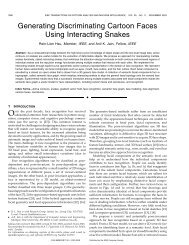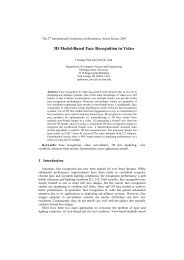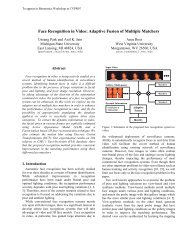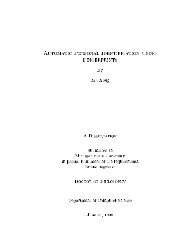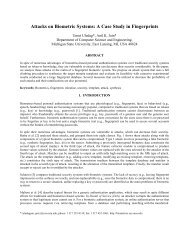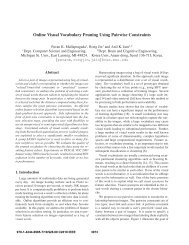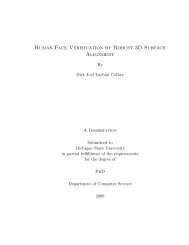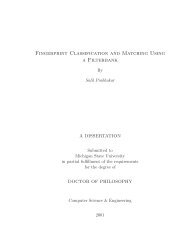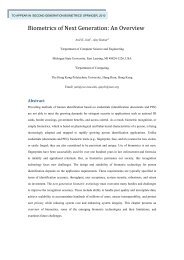Face Detection and Modeling for Recognition - Biometrics Research ...
Face Detection and Modeling for Recognition - Biometrics Research ...
Face Detection and Modeling for Recognition - Biometrics Research ...
Create successful ePaper yourself
Turn your PDF publications into a flip-book with our unique Google optimized e-Paper software.
where D σ (x) is the derivative of the Gaussian with zero mean <strong>and</strong> variance σ 2 , <strong>and</strong><br />
⊛ is the convolution operator. Unlike the Canny edge detector, our edge detection<br />
requires only a single st<strong>and</strong>ard deviation σ (a spread factor) <strong>for</strong> the Gaussian that is<br />
estimated from the size of the eye-mouth triangle.<br />
( ) −ws<br />
2 1/2<br />
σ =<br />
; ws = Max(dist io , dist em ), (3.14)<br />
8 ln(wh)<br />
where ws is the window size <strong>for</strong> a Gaussian, which is the maximum value of the<br />
interocular distance (dist io ) <strong>and</strong> the distance between the interocular midpoint <strong>and</strong><br />
the mouth (dist em ); wh = 0.1 is the desired value of the Gaussian distribution at the<br />
border of the window. In Fig. 3.12, the magnitudes <strong>and</strong> orientations of all gradients<br />
have been squared <strong>and</strong> scaled between 0 <strong>and</strong> 255. Fig. 3.12 shows that the gradient<br />
orientation provides more in<strong>for</strong>mation to detect face boundaries than the gradient<br />
magnitude. So, an edge detection algorithm is applied to the gradient orientation<br />
<strong>and</strong> the resulting edge map is thresholded to obtain a mask <strong>for</strong> computing the face<br />
boundary. The gradient magnitude <strong>and</strong> the magnitude of the gradient orientation<br />
are masked, added, <strong>and</strong> scaled into the interval [0, 1] to construct the face boundary<br />
map. The center of a face, indicated as a white rectangle in the face boundary map<br />
in Fig. 3.12, is estimated from the first-order moment of the face boundary map.<br />
The Hough trans<strong>for</strong>m is used to fit an elliptical shape to the face boundary map.<br />
An ellipse in a plane has five parameters: an orientation angle, two coordinates of the<br />
78



